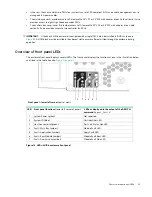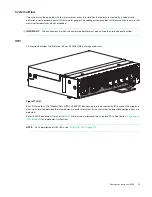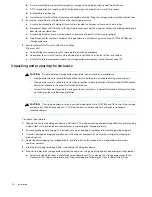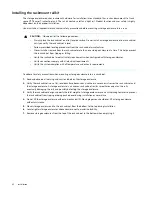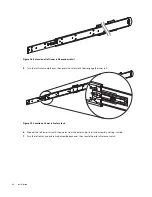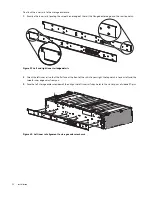
38
Installation
b.
A static-protected environment for temporary storage of the storage enclosure and the disk drives
c.
A T10 screwdriver, 6-in length, and #2 Phillips-head magnetic screwdrivers, 6- and 12-in length
d.
A retractable tape measure
e.
A mechanical lift with sufficient clearance and capable of safely lifting the storage enclosure without disk drives
4.
Ensure the rack cabinet is suitable for use with the storage enclosure.
a.
A rack cabinet capable of holding 4U form factors, leveled in all planes with respect to each other
b.
A maximum depth of 43.35 inches (1101mm) from back of front post to maximum extremity, excluding cabling and
door closure considerations
c.
A rack cabinet that causes a maximum back air pressure of 5 pascals (0.5mm water gauge)
d.
Weight capacity for the total number of storage enclosures installed, using a maximum of 310 lb (140kg) per
storage enclosure
5.
Secure sufficient staff to assist with the installation.
Minimum staff:
a.
One qualified service technician for the complete installation procedure
b.
One spotter to assist with the lift and to observe the installation from the rear of the rack cabinet
c.
A total of two to four people to unpack the storage enclosure and move it onto the mechanical lift
Unpacking and preparing the enclosure
CAUTION:
Do not operate a storage enclosure outside the manufacturer's intended use.
–
Storage enclosures are suitable for connection to intra-building or non-exposed wiring or cabling only.
–
Storage enclosures are suitable for installation in locations where the National Electrical Code (NEC) applies,
but are not suitable for Outside Plant (OSP) installations.
–
Customer facilities must provide for voltages with not more than ± 5 percent fluctuation. Customer facilities
must also provide suitable surge protection.
CAUTION:
The storage enclosure ships in a partially-populated state. All PCBAs and FRUs ship in the storage
enclosure, but the disk drives do not. It is still quite heavy, so handle with care and adhere to Seagate
recommendations.
To unpack the enclosure:
1.
Prepare the site for the storage enclosure installation. This includes meeting all product specifications and providing
a clean, clear, static-protected environment prior to unpacking the storage enclosure.
2.
Examine packaging for damage. This includes cuts, water damage, or evidence of mishandling during shipment.
3.
If there is damage, photograph and document it, but do not proceed. You must retain all original packaging for
product returns.
4.
Remove pallet strapping, the cardboard base, and all protective foam above the storage enclosure to access
container contents.
5.
Slide the plastic bag to remove it from surrounding the storage enclosure.
6.
Prepare to remove the storage enclosure from the container, using one of two options, depending on the shipment:
a.
Default provided belt straps: Locate three to four people to assist in moving the storage enclosure onto the
mechanical lift, using an appropriate safe lifting technique and following the steps for default belt straps.


